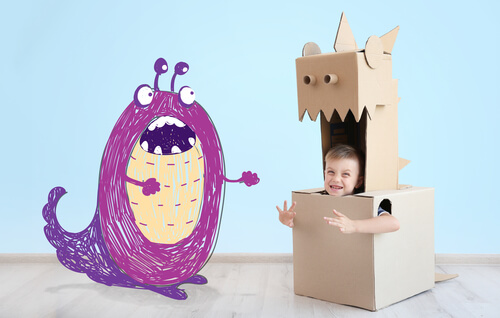The Anger Box: A Useful Tool for Controlling Negative Emotions

It may be hard to believe, but rage can actually be turned into something positive. An anger box, a tool for controlling tantrums in children, can do the trick.
As a result, you get a child with an excellent conscience and good self-control.
An erupting volcano
At this early age, little ones have yet to gain control of their emotions.
The prefrontal cortex, responsible for regulating emotions, is still immature. As a result, it’s normal for children to have reactions similar to volcanic explosions.
Parents must equip themselves to deal with these tantrums. Soon enough, your child will be capable of coming to her own conclusions.
If she thinks that tantrums are an effective way of getting what she wants, then she’ll do nothing to avoid them.
The best option is to act immediately, and the anger box will help you meet your goal.

Anger demands more self-control
Psychologist Maria Martin came up with the idea of the anger box as a tool for controlling tantrums.
The anger box helps children channel their feelings of anger, one of the emotions that requires the greatest level of self-control.
What a tantrum!
The anger box was inspired by the children’s book “What a tantrum” by Mireille d´Allancé, about a little boy named Robert.
The book tells about a bad day in Robert’s life. At night, after facing a series of negative situations at school and at home, Robert explodes.
A giant monster takes control of him, destroying everything he can get his hands on.
The monster disappears
However, Robert starts to reflect upon his actions and decides to fix things. He makes his bed, arranges his books, and picks up the lamps and toys that he’d thrown on the floor.
As he did so, he noticed that the monsters started to disappear and his anger started to fade.
At the same time, he started to realize all the damage he had caused. Now, his anger could fit in a box.
Robert transformed his rage into something positive.
First, he learned that he could face his anger. Second, he learned that allowing that monster to take over was damaging to him and his surroundings.
The moral of this story has to do with understanding anger and learning to face it, rather than avoid it.

The anger box as a tool
The anger box is a relaxation technique that helps children understand their emotions through drawing.
It also illustrates the impact their emotions have on them and their family.
Doodle away
After reading Robert’s story, give your child a paper and several crayons or markers.
Allow your child to scribble or doodle, using his impulses as inspiration. He’ll continue to draw until he’s relaxed.
Once your child has finished drawing, it’s time to bring the fun into the strategy.
Ask your child to put eyes, arms and legs on the drawing. That way, the monster will have an identity and your child will be able to recognize the emotion.
When the drawing has these final details, it’s time to crumple up the paper and stick it inside a box. If the box is closed tightly, the monster won’t be able to get out.
The triumphal defeat of the monster
The anger box allows your children to face this uncontrollable and harmful feeling that seems to take over them.
The more they draw, the more the monster will be tamed. This will be a triumph for your children because they’ll have learned to control their anger and defeat the monster.
Each time they feel frustrated or angry, they can draw a new monster and shut him away. Little by little, they’ll regain control and turn their negative emotions into something positive.
With each drawing, the monster will take on new colors and shapes. Parents can observe the different scribbles with their children and talk over what they felt in each case.
Anger boxes are useful tools for anger control. The idea is not to change behaviors, but rather solve unpleasant situations and calm your child.
All cited sources were thoroughly reviewed by our team to ensure their quality, reliability, currency, and validity. The bibliography of this article was considered reliable and of academic or scientific accuracy.
- Federación de Enseñanza de CC.OO. de Andalucía. (2011). “Las rabietas en la etapa infantil”. En: Temas para la educación. Revista digital para profesionales de la enseñanza. https://www.feandalucia.ccoo.es/docu/p5sd8748.pdf
- Pearce, J. (1995). Berrinches, enfados y pataletas. Soluciones comprobadas para ayudar a tu hijo a enfrentarse a emociones fuertes. Barcelona: Paidos.
- Sáez Ruiz, D. (2000). La psicología al alcance de los padres. Consejos para papá y mamá. Valencia: Ed. Promolibro.
- Vallejo, M. P. (2010). Las Rabietas. https://archivos.csif.es/archivos/andalucia/ensenanza/revistas/csicsif/revista/pdf/Numero_31/MARIA_PEREZ_2.pdf
This text is provided for informational purposes only and does not replace consultation with a professional. If in doubt, consult your specialist.
